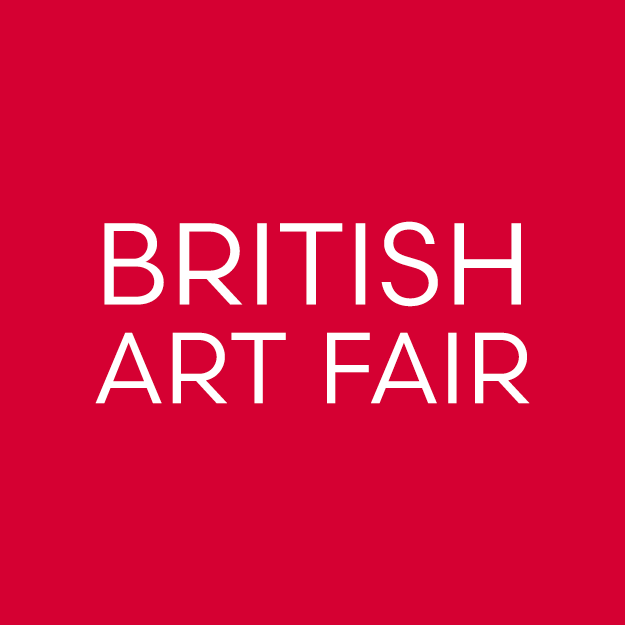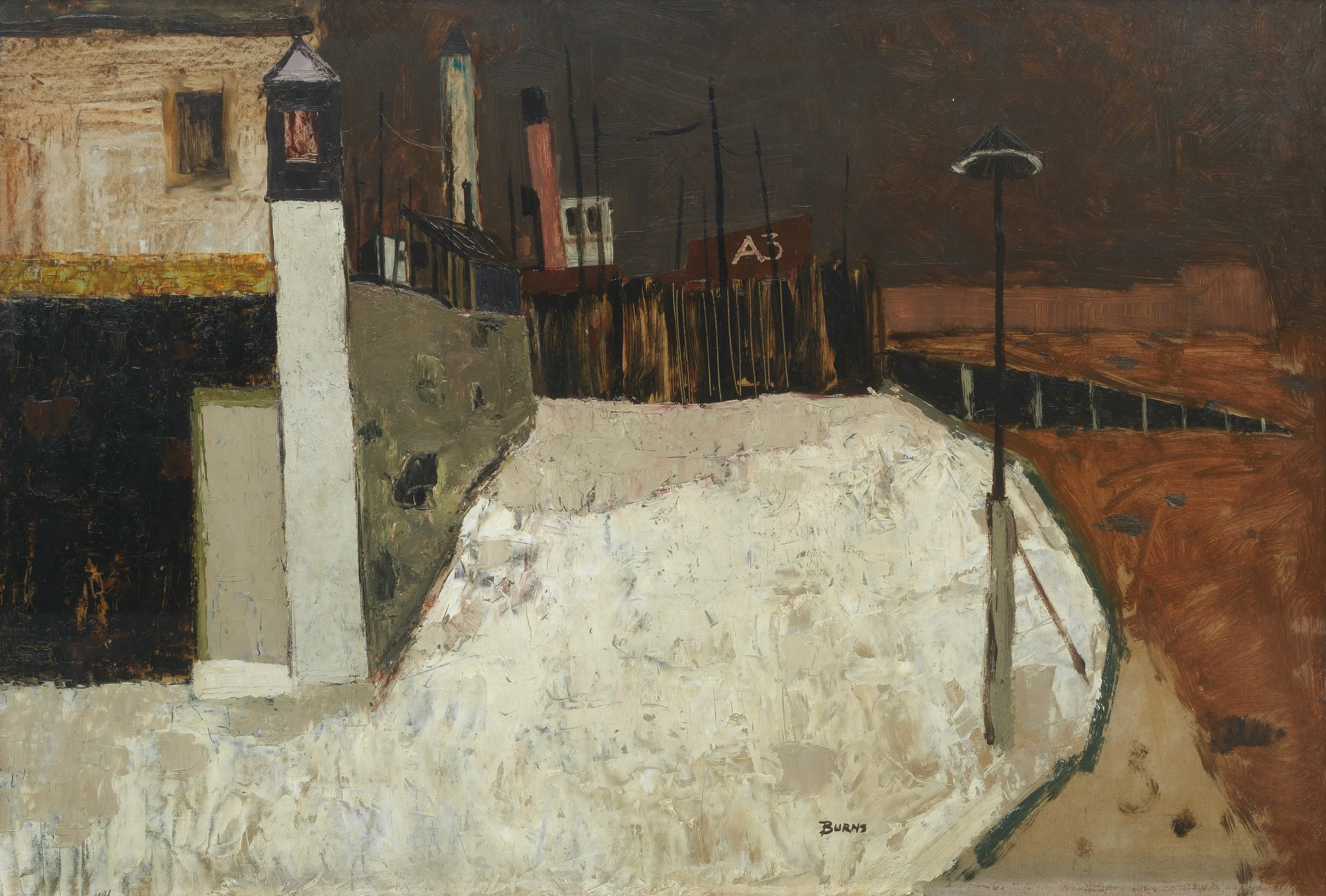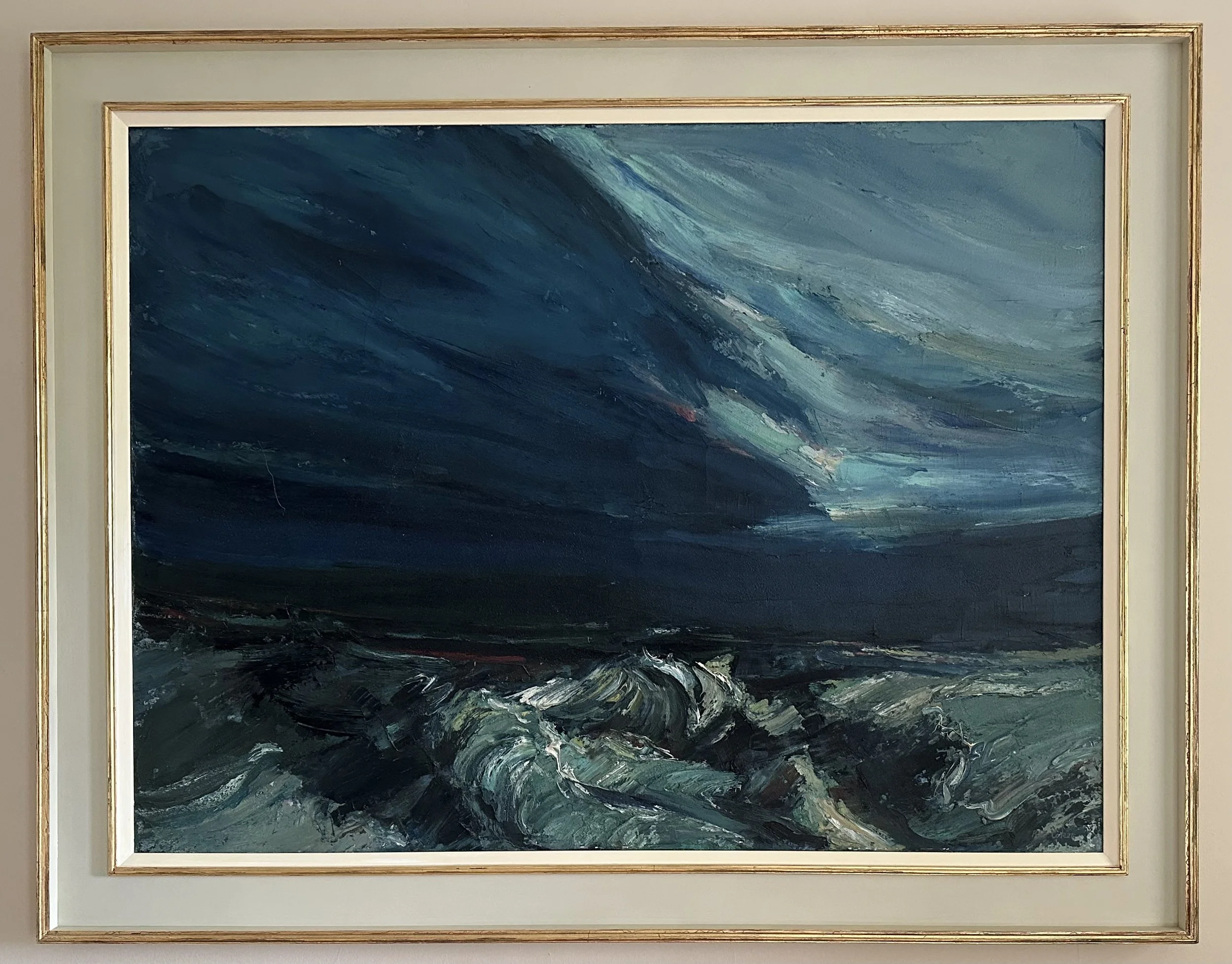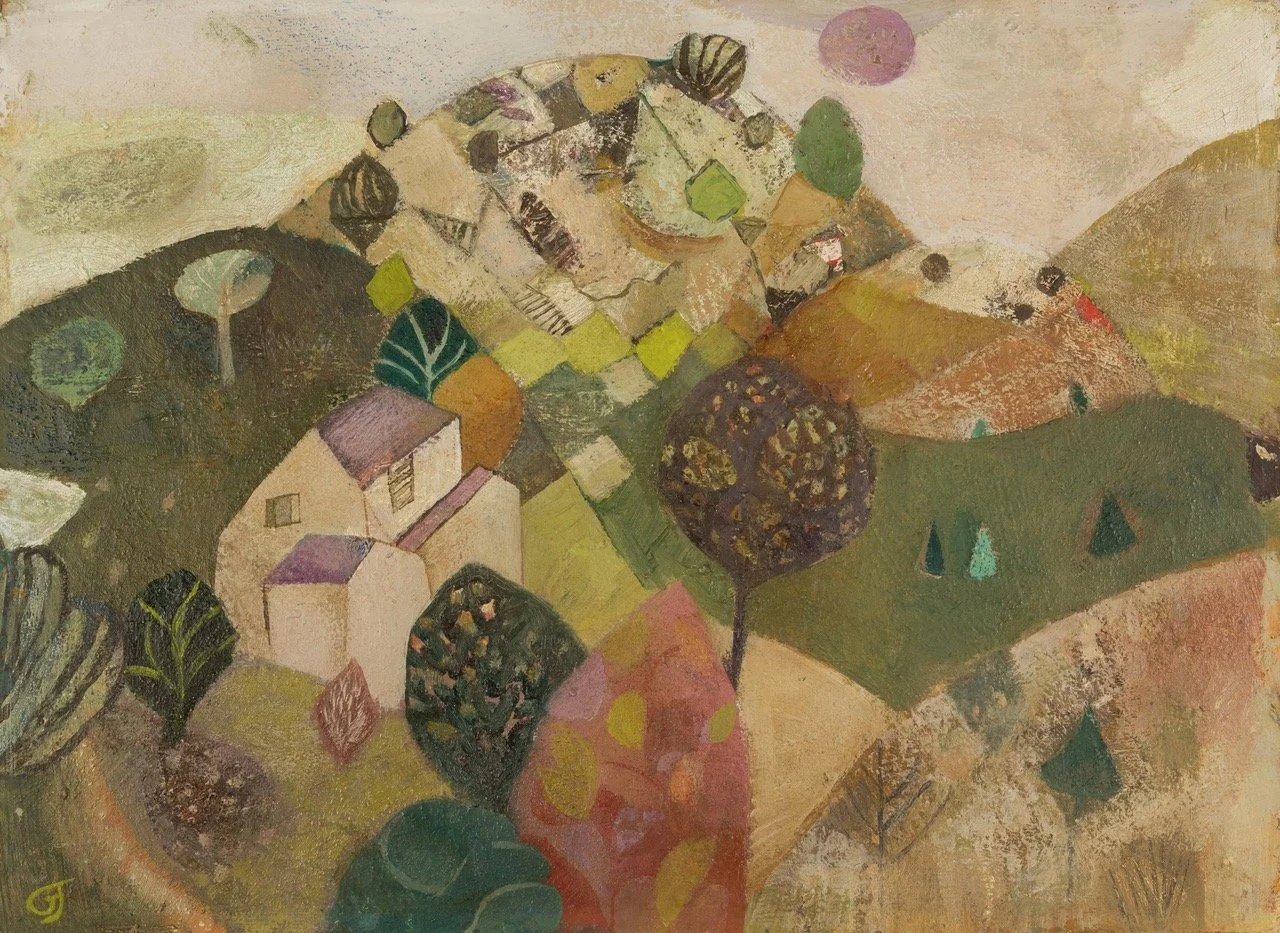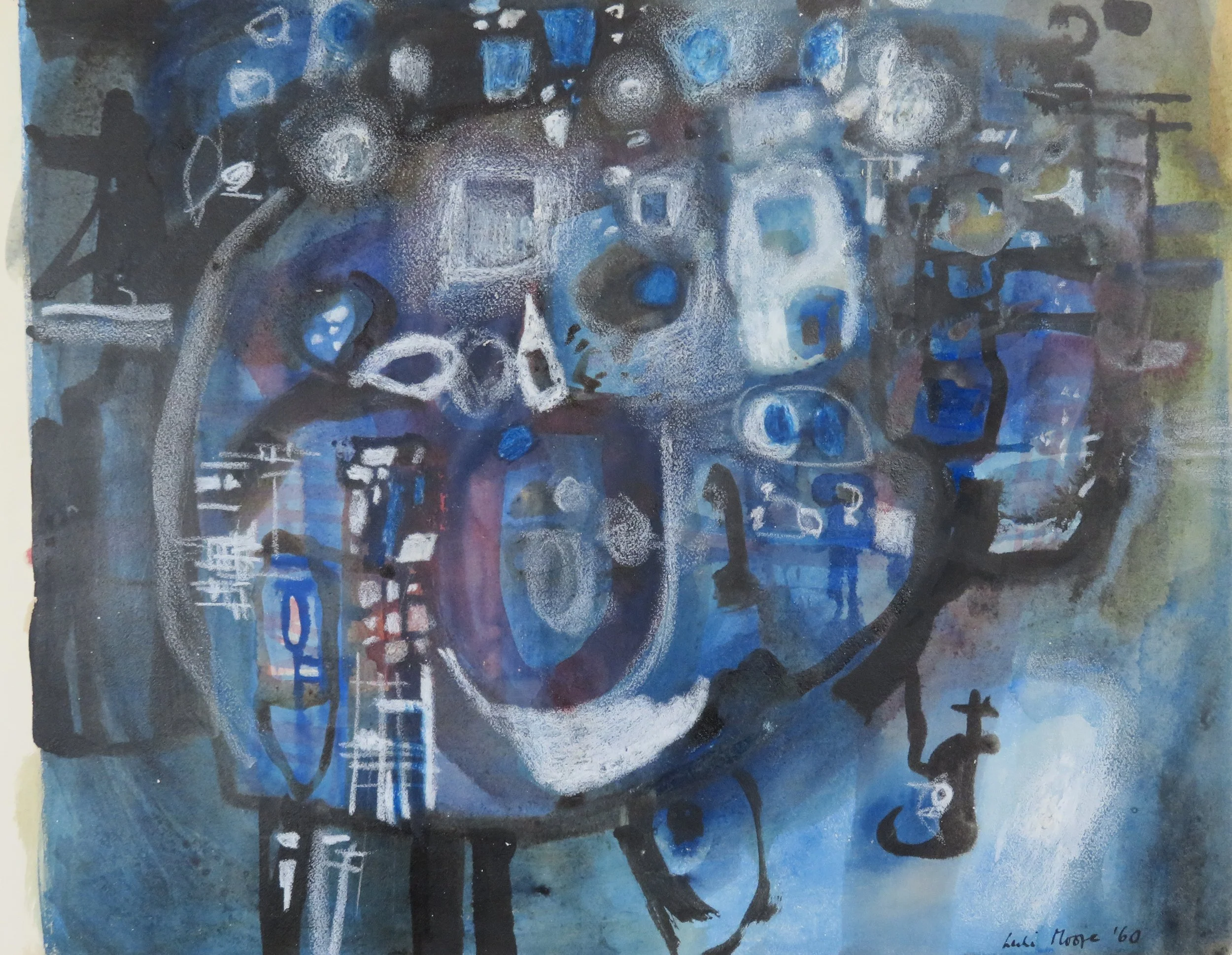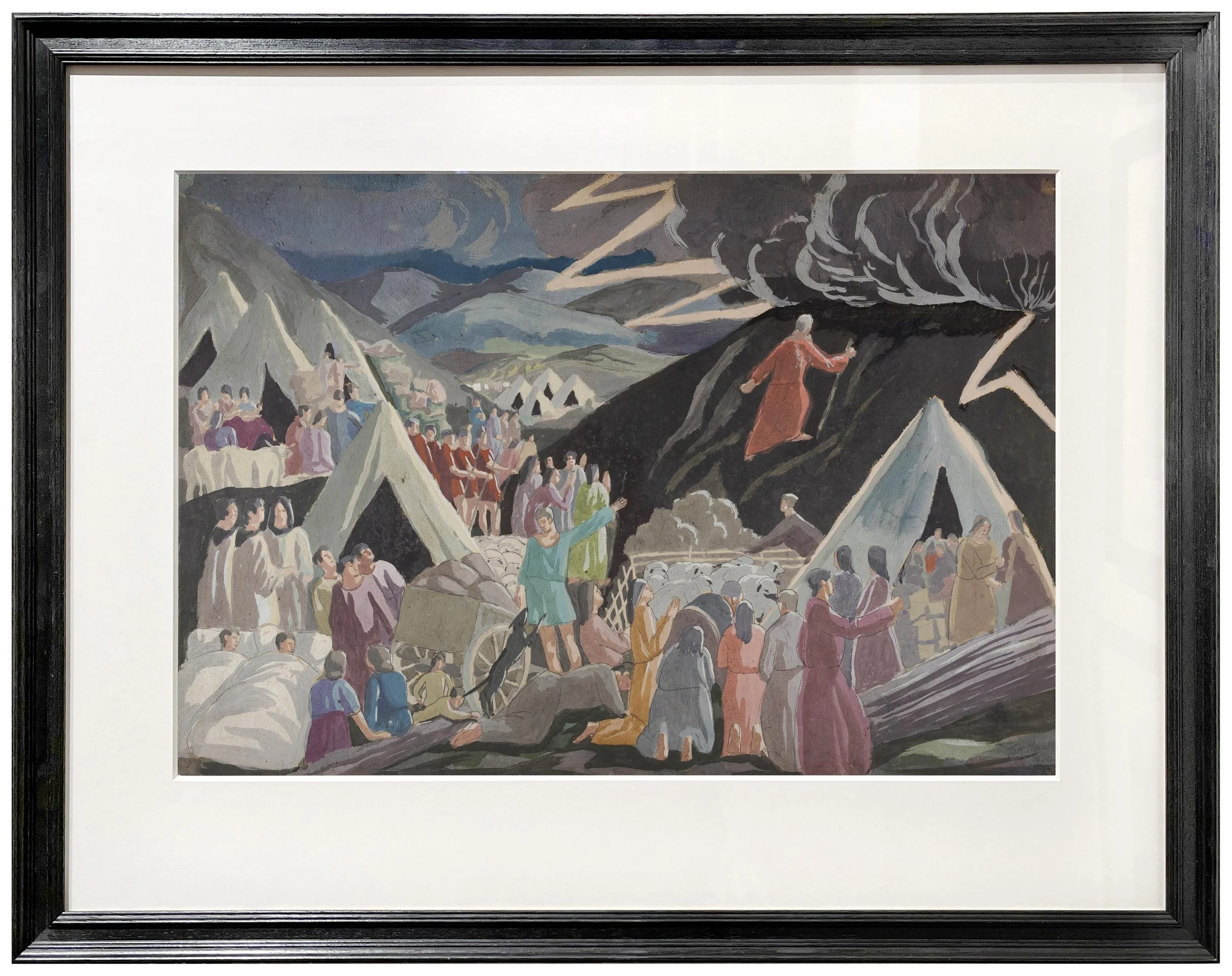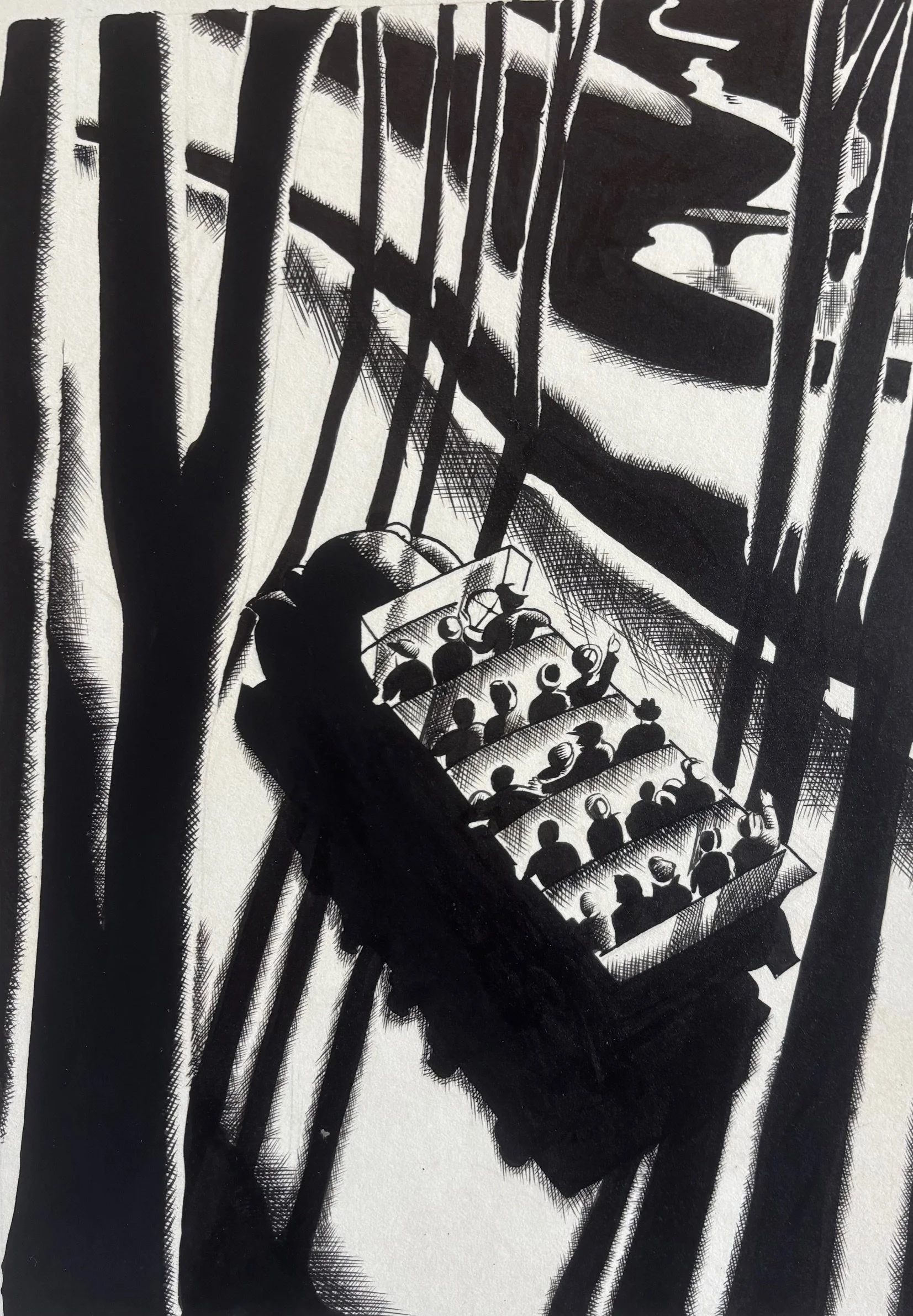Unsung
This exhibition takes a dip into the vast reservoir of undiscovered, underappreciated and undervalued talent that permeates the footnotes of 20th century British art history. Each gallery was asked to nominate a 20th century artist whose work they felt had been overlooked by either art history, the art market, or both. We have limited the selection to artists of the past but have included some older generation living artists where a historical perspective could be made.
The significant role dealers have played in the discovery and revival of interest in artists of the past has itself been often overlooked but is indisputable. The biographical notes in the online catalogue provide some context for their selections.
The artworks shown reflect as many ways as possible in which an artist could qualify as being underrated or unsung, from a totally new discovery or previously unknown estate to an artist who is well recorded but has somehow slipped under the radar.
Numerous artists seemed to miss the boat because they focussed more on a reliable income from teaching. Many found they were eclipsed by their partners or sidelined because of their gender. Some remained in Wales or Scotland, remote from London’s controlling influence.Others diversified too much in the media they worked in or were out of step with fashion. Every artist tells a different story.
Mary Adshead (1904-1995)
Still-life of Poinsettia with Leopard Skin, c. 1935
Signed, oil on canvas
88 x 73 cm
£9,750
After studying at the Slade School of Fine Art with Rex Whistler, Adshead became a muralist. Over her long career she was also a book illustrator, a stamp designer and a mosaic designer. In 1929 she married the painter Stephen Bone, son of the successful artist Sir Muirhead Bone, and they collaborated on several book illustration and mural projects. Working at a time when expectations of women were still largely confined to issues of domesticity, her prodigious professional output was noteworthy but, as The Independent’s obituary for her noted: “Her life reflects the difficulties of women figurative artists of her generation: the balance of the cares of wife-and-motherhood against the vicissitudes of painting in the post-war decades when figuration had been swept aside by abstraction in the galleries of Britain.”
Adshead was the subject of a retrospective at The University of Liverpool Art Gallery in 2005.
Victor Anton (1909-1980)
Trajectory, 1951
Signed, dated ’51 and numbered 1/12 (edition never completed), engraving on laid paper
30 x 8.9cm
£575
Why did he become a footnote? “He was born and died at the wrong time,” says Dominic Kemp, “so he was already in his mid-fifties come the 1960s when his style of work took off – precise perspex sculpture and Op Art images in black and white. While the artists that have endured were young, in their twenties and thirties, he was old enough to be their father, he didn’t fit in with the cool set, he quite literally missed the groove. It meant, too, that while other Op/Pop artists, Constructionists and Situationists continued their careers well into the 21st-century and were able to ensure their legacy with the return to fashion of their work, Anton died in 1980, just when the work was at its least fashionable, his career petering out due to chronic arthritis and a battle with cancer.”
Ray Atkins (b. 1937)
Philip White sat on a sofa reading - Liverpool, 1963
Oil on board
68 x 79 cm
£6,400
Influenced by Frank Auerbach who taught him in the 1950s, and admired by Leon Kossoff, Atkins, taught fairly consistently from 1965 at art colleges in Bournemouth, Reading (from 1970), Epsom and Falmouth (until 1990). A plein air, expressive landscape painter, he had a solo show at the Whitechapel Art Gallery in 1974. From 1989-2015 he showed with Michael Richardson’s Art Space gallery which championed figurative painting when it was out of fashion. After he retired from teaching, Atkins continued to live in Cornwall, exhibiting at Art Space and at occasional public venues like the Royal West of England Academy. But his very large paintings with thickly applied impasto were hard to place and in 2009 he distanced himself from the British art world and went to live in the foothills of the French Pyrenees where he converted an old barn into a studio with storage space for some eight hundred paintings.
His most recent show in the UK was last year at Belgrave St Ives accompanying the launch of a book on Atkins by the West Country based writer and supporter of neglected artists, Peter Davies. The introduction is by Lucian Freud’s biographer, William Feaver, with a short text by the France based artist David Stoker, who discovered Atkins working in the Pyrenees as a near neighbour. Castlegate House Gallery’s Steve Swallow clearly feels Atkins has been unjustly overlooked. “I think his decades of teaching probably impacted his drive for further recognition and limited the possibility of further funding through sales,” he says. “Like many good artists who taught, he just slipped through the net.”
William Burns (1921-1972)
The Boatyard, c.1952
Signed lower centre, oil on board
60 x 90.5 cm
£7,500
Provenance: Paintings in Hospitals
Having served in the RAF during WWII, Burns went to study at Glasgow School of Art. He then taught and lectured on art in Aberdeen, receiving a one-man show at The Scottish Gallery during the Edinburgh Festival in 1968. During that period, he shifted from traditional landscape painting to semi abstraction becoming one of most radical painters working in post-war Scotland using a distinctive arial perspective derived from his flying experience. In 1970 he quit teaching to focus on producing art for sale and exhibiting in Scottish commercial galleries, but he never had a chance to develop professionally as his life was cut short when he died in a flying accident two years later aged fifty-one.
“Today, as collectors and curators reassess the undercurrents of Scottish modernism, William Burns stands as a quietly radical figure, a figure overdue for reassessment” says Tommy Zyw of the Scottish Gallery.
Simon Bussy (1870-1954)
Antelope, Nager, 1940
Signed with initials and dated (lower left), oil on canvas
32.5 x 23.5 cm
£22,000
Browse and Darby. Simon Bussy 1870 – 1974. French artist embedded in the fashionable Bloomsbury set through his marriage to Dorothea Strachey, sister of Lytton Strachey in 1903. Inspired by countless visits to the London Zoo, Bussy’s careful renderings of exotic birds and creatures in both oil and pastel are his best-known works, and demonstrate his immense skill as both a draughtsman, and a colourist. Although at odds with the style of the time in which they were produced, these works emit such delight and consideration that onlookers are challenged to examine them closely and see the depth of colour and careful reflection present in each work.
Geoffrey Clarke (1924-2014)
Study for Sculpture (176), 1956
Signed, sugar lift aquatint on paper
113 x 76 x 5 cm
Edition of 30
£4,500
Clarke held his own with the ‘Geometry of Fear’ artists of the 1950s, Chadwick, Armitage, Butler et al., exhibiting his welded iron sculptures at the Venice Biennale in 1952. But his interest and practice in other media – mosaics and stained glass – slightly confused his image as an avant garde sculptor with that of a decorative artist, and, because of church commissions, as an ecclesiastical artist in a secular age. He also embarked on a teaching career, first in Colchester and then at the Royal College of Art where he was head of the department of light transmission and projection. Today, such polymathic pursuits would be considered a boon to an artist’s career, but in Clarke’s case they are still being reassessed.
Jean Patricia Taprell Clark (1930–1973)
Whirlwind
Oil on canvas board
45 x 33 cm
£800
Jean Patricia Taprell Clark was born in Kingston, Surrey. Having refused the opportunity to become a member of the 'Bluebell Girls' dance troupe, preferring to become a painter, she went on to study at the Wimbledon School of Art, where she met Raymond Briggs, later to become famous for his illustrations to The Snowman. The couple married in 1963 and relocated to Sussex after Briggs accepted a position as a part-time lecturer in illustration at Brighton [Polytechnic Art] School of Art. Jean grappled with schizophrenia and agoraphobia, which deeply affected her life. Reflecting on her condition, Briggs wrote, "Schizophrenics are inspiring people. Her feelings about nature and experiences of life were very intense." Jean passed away from leukaemia in 1973 but appears never to have had any gallery exposure as an artist.
Henry Cliffe (1919-1983)
Landscape, Late Evening, 1956
Signed and dated, oil on board
44 x 35 cm
£3,750
A painter of lyrical abstracts, Cliffe was an influential teacher at the Bath Academy of Art during the post war era alongside William Scott, Peter Lanyon, Terry Frost, Bryan Winter, Howard Hodgkin and Adrian Heath - all artists who have received institutional recognition and sold for considerably more than him.
Prunella Clough (1919-1999)
Oblique I, 1987
Signed verso, oil on canvas
76 x 76 cm
£38,000
Provenance: The Artist; New Art Centre, London; Sotheby's London, March 2008; Private collection, UK
Exhibitions: The New Art Centre, London, no. 106/25
Like many mid-twentieth century women artists, Prunella Clough was often overlooked and unsung. This was particularly so until her major 2007 show at Tate Modern, which travelled to Norwich Castle Museum and then Abbot Hall Art Gallery, Kendall.
Stephen Deuchar’s foreword to this exhibition neatly sums up her relevance to Unsung at British Art Fair, 2025:
‘At her death in 1999 Prunella Clough was rightly acclaimed as one of the most interesting British painters of the post-war period. Yet while her work consistently found critical approval and has attracted a devoted and loyal following, she is not known to a wide public. This is perhaps partly to do with the artist herself, who throughout her long career received many invitations and requests to exhibit, which she invariably refused – the consequence of her intensely private character. The nature of Clough’s work, which tends to be subtle [as can be seen in ‘Oblique I’], considered and complex, may also be a factor.’
Peter Coker (1926-2004)
Storm, 1968
Oil on canvas
86.4 x 122
£30,000
Coker obtained some fame in association with the Kitchen Sink School in the 1950s with grim figurative paintings of butchers’ shops. But after his first London show in 1959, the art world became besotted with American abstraction and ‘Coker vanished from the newspapers and arts reviews almost without trace,’ (Guardian obituary.)
Nonetheless he continued to practice his own type of gritty and graphic realism throughout his life. As Jane Holdsworth (Flying Colours), who first exhibited him in 1990, writes: ‘Fascinated by the movement of weather and water and inspired by Turner, he sought subjects which revealed powerful elemental forces at work. Winner of two scholarships at the Royal College of Art and later a Royal Academician, Coker had a long and distinguished career, with work in around 50 public collections. Peter Coker is one of the foremost British realist painters of the 20th century.’
Anthony Eyton (b.1923)
Still Life, 2023
Signed, oil on canvas
40 x 33 cm
£13,500
A figurative painter associated with the Euston Road School in the 1950s, Eyton is 102 years old and still going strong. Like many artists who devote much of their energies to teaching, (Camberwell and Royal Academy Schools) he has never received proper recognition from art institutions or the market, apart from a retrospective at the South London Art Gallery in 1980. Less than one hundred works have sold at suction in the last fifty years for a top price of just £10,200.
Peter de Francia (1921-2012)
Resting Figure, 1951
Oil on canvas
71 x 91.5 cm
£7,500
Growing up in the post-war era, de Francia adopted a powerfully figurative and graphic style of critical social realism that owed much to Goya, Beckmann, Grosz and Picasso, and found favour with left wing intellectuals such as John Berger who shared his political leanings and the politics of his art. But he was out of step with the avantgarde – the art informel or abstract expressionism that dominated, which meant that he suffered from critical neglect. He earned more respect as a teacher first at Goldsmiths College from 1969 and then at the Royal College of Art until 1986. In 1977, the art critic Richard Cork wrote that “despite his prominence as a Professor at the Royal College of Art, his work is of a more or less unknown quality outside a close circle of friends and colleagues.”
James Hyman has been the principal commercial gallery to show his paintings since 2005 and with his estate since his death. But despite posthumous institutional exhibitions at Tate Britain and Pallant House Gallery, de Francia has yet to command a five-figure price at auction. Consequently, although his work can sell for more privately, it remains unsung in the salerooms.
Madge Gill (1882-1961)
Untitled, 1951
Signed and dated 1951 on verso, ink on card
48 x 60 cm
£7,000
A self-taught outsider artist, Gill was orphaned in Essex aged nine and sent to Canada aged fourteen where she worked in domestic service before returning to Essex where she lived with her aunt who introduced her to spiritualism and astrology. From the age of 38, married and with children she began to draw obsessively, intensely focused geometric patterns populated with wide eyed children. Although her work was exhibited, she never sold anything claiming the work was owned by a spirit called "Myrninerest" (my inner rest) who guided her. In the present century her work has been included in Tate’s Outsider Art exhibition (2006) and in the Venice Biennale’s Foreigners Everywhere exhibition (2024) but is not shown by any major gallery.
Kathleen Guthrie (1905-1981)
Red Centre, c. 1970
Signed and titled verso, acrylic on canvas
51 x 61 cm
£4,000
Provenance: Artist's studio (6 Mall Studios, London); Private collection
Painter, printer, textile designer, muralist, writer and illustrator of children’s books, Kathleen Guthrie could turn her hand to any art form, and indeed to any style. Her early work, when married to artist Robin Guthrie, was figurative and decorative, but after she married her second husband, the abstract painter Cecil Stephenson, geometrical abstractions became her thing. For someone so multi-talented and versatile she never achieved the critical status she deserved at a time when women artists were not given proper recognition. Many of her abstracts were based on works by her husband.
On the website, ‘Unsung Heroines’ are one-hundred-and-forty-seven 20th century British women artists, including Guthrie. In the introduction it states: “Many of these women were married to artists and it is no surprise that usually their husband's work is, inevitably, better known. Although women were at least allowed, for the first time during this period, to attend art school, their continued relative obscurity raises interesting questions about the confines that other conventions and obligations placed them under.”
Gertrude Harvey (1879-1966)
Anemones, 1957
Signed, oil on canvas
46 x 46 cm
£9,750
Brought up in the artist’s colony of Newlyn in Cornwall, Gertrude Bodinnar was largely self-taught through her experiences as an artist’s model at the Forbes School of Painting through which she met leading local artists such as Harold Harvey, whom she married, and Harold and Laura Knight. Whilst Gertrude occasionally exhibited with her husband, he was far better known, overshadowing her reputation. That imbalance persists in the market today where his record price at auction is over £100,000, whilst hers is just £1,400. There is no more qualified gallery than Messums, a driving force in Newlyn market research and scholarship, to spot that imbalance and remedy it.
Gwyneth Johnstone (1914-2008)
Landscape with Tree and House, 1960
Signed with monogram, oil on board
37 x 50.5 cm
£13,500
Exhibited: Granada, Spain, Galeria Arrabal, 'Gwyneth Johnstone', cat. no.21
An illegitimate daughter of Augustus John, Johnstone was always considered an outsider to her father’s elite bohemian clan. She had a nomadic streak moving home from Norfolk to London and Paris, and from the south of France to Spain and back again, just as her paintings betrayed a variety of influences from the Italian Renaissance to European modernism. Along the way she found galleries to exhibit her work and people and institutions to buy it but never established a consistent artistic reputation so has been unsung.
William Johnstone (1897-1981)
Black and Red I, 1975
Signed and dated, ink on paper
78 x 59 cm
£2,950
Provenance: From Ancrum Gallery, then Scottish Gallery
Hence private collection
Scottish abstract expressionist painter who dripped before Jackson Pollock but pursued a career in teaching rather than commercial gain through the gallery system. Has been honoured with a retrospective at the Hayward Gallery, but apart from a phenomenally successful studio sale back in the 1980s, in contrast to the market for lesser known American Abstract Expressionists whose market has boomed, Johnstone’s has remained inexplicably static.
Peter Lowe (b. 1938)
White Relief 2, 1975
Signed and dated ‘75 on the reverse, painted wood and fiberglass
81 x 81 x 13 cm
£12,000
Provenance: Artist’s Studio
A member of the Systems Group in the 1970s who produced geometrical abstract reliefs associated with the Constructivist movement...Victor Pasmore, Kenneth Martin et al. Although Constructivism, with its roots in early 20th century Revolutionary Russian art, has been broadly recognised internationally, it has not in the UK, and was superseded in the 1970s by conceptual art. There is a collector base now, but quite small, so could grow.
Alan Lowndes (1921-1978)
Love near the tripe works, 1963
Signed, oil on board
76 x 61 cm
£24,000
A self-taught artist from Stockport, Lowndes painted post-war city life from a poetic, working-class perspective. When he moved south to St Ives, street life was taken over by the sea.
Compared to L.S. Lowry for the feel of his subject matter, his work was less dependent on graphic skills, and more colourful. Often referred to as “the poor man’s Lowry” (because his work was much cheaper), the artist Terry Frost thought Lowndes was a better painter than Lowry – though that has not been reflected in museum exhibitions or the market. Supported by Crane Kalman throughout most of his adult life, and sold to their film star clientele, including Charles Laughton, he has never been recognised with a museum show.
In 2008 he was selected by Grayson Perry for inclusion in his ‘Unpopular Culture’ exhibition in Bexhill-on-Sea. In Crane Kalman’s centenary show in 2021 the critic David Noel Smith wrote that “It’s time for Alan Lowndes to emerge from LS Lowry’s shadow.”
Leslie Moore (1913-1976)
Night Lights, 1961
Signed and dated, mixed media on paper
44 x 55 cm
£600
Leslie Moore was a Welsh neo-romantic artist who participated regularly in the National Eisteddfod and occasional gallery shows in Cardiff and Swansea. His work is represented in national collections in Cardiff and Newport, but seems to have shown mainly in Wales which is why, perhaps, he has been ‘seriously neglected’, says Hughes.
Tom Saunders Nash (1891-1968)
Moses Ascending Mount Sinai, 1930
Signed, pen, ink and gouache on paper
38.09 x 54.59 cm
£2,750
Exhibited: Probably the artist's posthumous retrospective, Reading Art Gallery, 1980, No.17
A painter of Biblical subjects, Nash studied at the Slade School of Fine Art, 1909–12, where he met such artists as Stanley Spencer, who was a major influence on his work, experiencing almost daily 'visions and experiencing dreams.' For a while he shared a house with Spencer’s brother, Gilbert. The Westminster Gazette noted a similarity between the two and asked: 'did Spencer copy Nash, or Nash, Spencer? ‘ History clearly judged in Spencer’s favour as has been applauded with numerous exhibitions and million pounds prices while Nash remains relatively unsung.
Patrick Procktor (1936-2006)
Kirsten in Sidi Bou Said , 1975
Titled and dated lower right 'Kirsten in Sidi Bou Said 75', pencil on paper
28 x 20 cm
£9,500
Provenance: The Estate of the late A.R. Shepherd, CBE (Langan’s Brasserie chef and partner)
For its inaugural appearance at the British Art Fair, Winsor Birch, run by former Sotheby’s British art specialists Grant Ford and Charlie Minter, have secured the collection of the late Richard Shepherd, the chef who famously rescued Langan’s Brasserie, the favoured watering hole of actors (Michael Caine) and artists (David Hockney and Patrick Procktor) when it was on the verge of insolvency. Among them are a group of works by Procktor one of which will feature in Unsung.
Procktor was arguably as famous and successful as Hockney in the early 1960s, with sellout shows at the Redfern Gallery and inclusion in the trend setting New Generation exhibition at the Whitechapel in 1964 together with Hockney, Bridget Riley, John Hoyland and Patrick Caulfield. But by 1970, increasingly identified as an unfashionable figurative and topographical watercolourist, the slow descent into what the art critic John McEwen in his obituary described as “thirty years of comparative eclipse” had begun. In 2013 Frieze Magazine published a review of a Procktor retrospective at the Huddersfield Art Gallery in which the author, Michael Bracewell, referred to “tantalising flashes of greatness” that could remedy Procktor’s “unfairly neglected” status.
Alick Riddell Sturrock (1885–1953)
Challow Farm, Dorset, c.1932
Signed, oil on canvas
63.5 x 76.2 cm
£7,500
Exhibited: Royal Scottish Academy, Edinburgh, 1932, no.427
Sometimes compared stylistically to the brothers Paul and John Nash, “Sturrock was a "Modern" in that he belonged to his time, and a "Traditionalist" in that his roots were deep in the native School” (Royal Scottish Academy obituary). “Like many Scottish artists he has been unsung because he was overlooked by a London centric artworld. English critics are selective when it comes to recognising and embracing their Caledonian counterparts.” (Emily Walsh, Managing Director, The Fine Art Society)
Graham Sutherland OM (1903-1980)
Study : Limestone Quarry, Drilling Rocks, 1943
Pencil, ink and chalk
26.7 x 26 cm
£20,000
The best known of this Unsung group, “Sutherland was considered more significant than Francis Bacon in the early 1950’s,” says Christopher Kingzett, “and throughout that decade had strong claims to be Britain’s best-known artist in America and on the Continent. In the second half of his career, though, he was considered something of a lightweight painting largely decorative pictures with nothing to say (his pictures of toads came in for particular criticism). His most articulate proponent, Douglas Cooper, dropped him and although supported by Marlborough he attracted the attention of a smart international set which did nothing to bolster his reputation.”
“In the second half of his life he (or more probably his wife, Kathleen) allowed too much second rate stuff to get out of the studio. The Tate held a retrospective in 1982, but apart from an exhibition of his 1940s work at the Dulwich Picture Gallery in 2005, he has not been receiving the plaudits he deserves. Nowadays he is totally out of fashion.” He may have reached a million dollars at auction for his Crucifixion, 1947, in 2011, but most of his work at auction today sells below estimate.
Hanna Weil (1921-2011)
Esteban, Segovia, 1960
Signed, oil on canvas
91.4 x 66 cm
£1,500
Weil’s family fled Nazi Germany in 1932, and she studied art in London, then taught art until 1987. Being both a woman artist and a teacher did not advance her career, but Anna Wakerley of Oriel Fine Art wonders if she has rather been overlooked thanks to her fondness for the decorative. “She loves rooflines – the more baroque the better – and her works convey an almost Ruskinian appreciation of ornament. Weil's paintings are steeped in the ancient histories of the cities she portrays, and the works often have a folkloric quality.”
Denton Welch (1915-1948)
Self-Portrait, 1943-46
Pastel on card
34 x 28 cm
£25,000
Better known in his day as a writer under the patronage of Dame Edith Sitwell, his painting has been overlooked by art history. Although he did exhibit with several galleries like Leicester in his short life, he has rarely been the subject of a solo show. Indeed, the last solo presentation of Denton Welch's art was over forty years ago at Abbott and Holder.
Swarbrooke compares the artist with the neo romantics John Minton and Keith Vaughan (with whom he was grouped in the Barbican’s The Last Romantics: The Romantic Tradition in British Art show in 1989), and even Edward Burra (the subject of a solo show at Tate Britain this summer). But his lowly status in the art market is illustrated by his auction record, a self-portrait drawing that sold, not at Sotheby’s or Christie’s, but at second tier Roseberys in 2017 when it quadrupled estimates to sell for £9,500... still leagues behind Minton, Vaughan and especially Burra.
His outsider status – as a gay man in a time when this was illegal, but also as someone physically removed from society by his illness (repercussion from a road accident aged fifteen) – is reflected in the rare, heightened sensibility in his art but may also have contributed to the neglect he suffered. As his biographer James Methuen-Campbell wrote in a note to the Tate’s only acquisition by Welch: “Welch's oeuvre is difficult to survey because it has not been exhibited or reproduced.”
William Wilson RSA (1905 - 1972)
A Street in Paris, c. 1953-54
Watercolour
77 x 50 cm
£3,500
A multi-talented Scottish artist, little known or exhibited south of the Border. Served an apprenticeship in a stained-glass studio and attended Edinburgh School of Art after which he became associated with the Etching Revival through his distinctive linear skills. His strong sense of colour was manifest in his watercolours and stained-glass designs which betray a strong mix of the medieval with the modern. Suffered from diabetes which caused blindness in his sixties. His talent recognised belatedly by the Royal Scottish Academy of Art and Architecture with a retrospective in 2022 but has not filtered through to the market. The auction records for his prints (£1,000), watercolours (£5,000) and stained-glass panels (£10,000) have all been set by Scottish auctioneers. Patrick Bourne staged exhibitions for Wilson in the 1980s, but thinks “The artist, like a lot of Scottish artists, is commercially unsung.”
Arthur Wragg (1903-1976)
Daytrip, 1930s
Inscribed with text from Psalm 115, verse 16 l.c..: Ps.115 but the earth he hath given to the children of men
Pen with brush and Indian ink on board
30 x 26 cm
£2,200
A freelance commercial illustrator whose dramatic chiaroscuro is comparable to the high art woodcuts of the German Expressionists . A committed socialist and Christian, Wragg tended to provide heavily politicised content for left wing publications, “A touch too hard-hitting to have become terribly commercial” says Moore-Gwyn. “But there is a case to be made for these striking black and white drawings.”
Austin Wright (1911 - 1997)
Venice, 1957
Signed AW 57 Venice, chalk
53.5 x 75.5cm
£3,850
Provenance: Collection of the artist
Exhibitions: Willoughby Gerrish Ltd, London, Austin Wright, 11 May - 10 June 2022; Thirsk Hall Sculpture Garden, Austin Wright, 13 September 2024 - 29 March 2025
Based in Yorkshire for most of his adult life, Austin Wright was self-taught. Described by the Manchester Guardian in 1955 as “The most gifted sculptor working in Britain today”, he was sponsored by the British Council to visit Venice in 1957 when this drawing was made as part of a series of sculptures depicting the ‘electricity of human interaction’ as he put it. In the same year he took part in the 1957 São Paulo Biennale where he won the Acquisition Prize beating other artists including Kenneth Armitage, Lynn Chadwick, Bernard Meadows and Reg Butler. The committee included some of the most influential curators, critics and writers of the period such as Roland Penrose, Sir Herbert Read, Sir John Rothenstein, and Lilian Somerville. Although he exhibited at adventurous London galleries like Roland, Browse & Delbanco and the Leicester Galleries in the late 1950s and early 1960s, after he won a sculpture Fellowship at Leeds University in 1961 he retreated entirely from the London art world, “No more willing to court favours from the metropolis than were London critics to travel north”, according to his obituary in the Guardian.
Catherine Yarrow (1904 - 1990)
Face (Self Portrait 2), c. 1955
Colour monotype
36 x 43 cm
£2,200
Provenance: Artists’s Estate
Catherine Yarrow studied drama in the 1920s before learning to draw while travelling in Europe where she met Giacometti and the surrealists and enrolled in Stanley Hayter’s printmaking Atelier 17 in Paris. Experiencing mental health issues she attended a Jungian psychiatric clinic in Switzerland. After the outbreak of war, she went to Spain where she befriended Leonora Carrington, and then, like Carrington, fled Europe for America. But as Catriona College of Austin Desmond Fine Art says, “She was a woman, a surrealist painter and therefore not taken seriously.” An exhibition at Austin Desmond Fine Art in 2012 witnessed strong sales at up to £5,000 to private and institutional collections but there has been no follow up since.
Nan Youngman (1906 - 1995)
Pageant to celebrate the Festival of Britain, 1951
Signed and dated, oil on panel
65 x 81 cm
£9,000
Like so many accomplished female artists of her day, Nan Youngman was Slade-trained (under the tutelage of Henry Tonks and Philip Wilson Steer, 1924-1927). However, to earn a living she had to combine part-time art teaching with her own painting." She was the mastermind behind the Pictures for Schools Exhibitions, with its first show at the Victoria and Albert Museum in 1947 and later made tours abroad for the British Council in connection with art education, starting with West Indies in 1952. Youngman’s reputation therefore was more as a teacher and exhibition organiser than as an artist.
This dynamic scene of a pageant celebrating the Festival of Britain in 1951 was painted in the Rhondda Valley but incorporates fantastical elements referencing the festival such as the futuristic, vertical steel "Skylon" structure that was built on the banks of the Thames to commemorate the emergence of Britain from the War. Youngman enjoyed a Kettle’s Yard retrospective in 1987 but has gone largely unsung since.
